
The Three Mouseketeers is the name of two separate talking animal comic series published by DC Comics.

The Three Mouseketeers is the name of two separate talking animal comic series published by DC Comics.
The original Three Mouseketeers were published in DC's humor series Funny Stuff, first appearing in Funny Stuff #1 (Summer 1944). [1] The strip was drawn by Ronald Santi. [2]
The series was a loose parody of the classic 1844 Alexander Dumas novel The Three Musketeers . In this case, the lead swordsmice were named Aramouse, Amouse, and Porterhouse (with young accomplice D'Artagmouse), and had various adventures while serving King Looey XIV. Their arch-enemy is Duke Bazook. [3]
The series ran in Funny Stuff until early 1948, after which the characters remained unseen for years. [4] The Mouseketeers were revisited in a 1982 Captain Carrot and His Amazing Zoo Crew time-travel storyline in which it is revealed the Mouseketeers are historical figures in Earth-C's version of France during the 17th century. [5]

The second Three Mouseketeers series appeared in a comic title of the same name, which ran from 1956 to 1960 for 26 issues. [6] They were created by Sheldon Mayer, though most of the work was done by Rube Grossman after the first few issues. [7]
Though the title was clearly inspired by Alexandre Dumas' novel The Three Musketeers , nothing else about the characters was, with no similarities to the earlier Golden Age series. The stories revolved around three mice, all members of a club. There was the pompous, self-styled leader, Fatsy, who was obese and wore a sailor's uniform similar to Donald Duck's, then Patsy, tall and dim-witted (also the only Mouseketeer to go without clothing), and last of all Minus, short, dressed in oversized t-shirt and baseball cap with the bill pointing to one side. Of the group, Minus was the most likely to get into trouble (a running gag had him getting many demerits from Fatsy) though this was usually not of a malicious nature. The mice met at a clubhouse, which was an old tin can with the open mouth covered by a leaf. The mice rarely used this entrance, preferring an underground secret entrance. Their adventures involved dealing with humans (whom they referred to as the Bigfoots), neighborhood cats, and a particularly nasty hawk named Hamilton.
The series ended its initial run when DC decided to concentrate on its line of superhero comics. The series did get a revival when it was reprinted for seven issues from 1970 to 1971; [8] later, in the 1980s, Mouseketeers stories were reprinted in digest format along with other classic DC talking-animal characters under the Funny Stuff banner.

All-American Comics was a comics anthology and the flagship title of comic book publisher All-American Publications, one of the forerunners of DC Comics. It ran for 102 issues from 1939 to 1948. Characters created for the title, including Green Lantern, the Atom, the Red Tornado, Doctor Mid-Nite, and Sargon the Sorcerer, later became mainstays of the DC Comics line.

Captain Carrot and His Amazing Zoo Crew! is a DC Comics series about a team of talking animal superheroes called the Zoo Crew. The characters first appeared in a 16-page special insert in The New Teen Titans #16, followed by a series published from 1982 to 1983. The Zoo Crew characters were created by Roy Thomas and Scott Shaw Although the series, which was the last original funny animal property to be created by DC Comics, proved short-lived, it is still fondly remembered by many comic fans of its generation, and the characters appear occasionally in cameos in the mainstream DC Universe.

The Inferior Five are a parody superhero team appearing in books by the American publisher DC Comics. Created by writer E. Nelson Bridwell and artist Joe Orlando, the team premiered in the DC Comics title Showcase #62.

The Shield is the name of several superheroes created by MLJ. Appearing months before Captain America, the Shield has the distinction of being the first superhero with a costume based upon United States patriotic iconography. The character appeared in Pep Comics from issue #1 to #65.

Captain Marvel Adventures was a long running comic book anthology series by Fawcett Comics, starring Captain Marvel during the Golden Age of Comic Books.

Hoppy the Marvel Bunny is a fictional character appearing in American comic books originally published by Fawcett Comics and later DC Comics as a spin-off of Captain Marvel. He was created by Chad Grothkopf (1914–2005), and debuted in Fawcett's Funny Animals #1. A comic book superhero and an anthropomorphic animal, Hoppy has made periodic appearances in stories related to Captain Marvel, today also known as Shazam or The Captain.
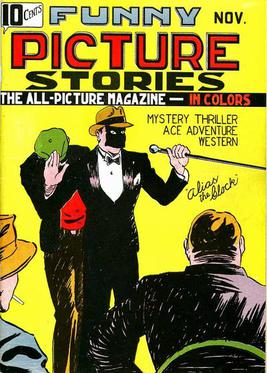
The Clock is a fictional masked crime-fighter character created in 1936, during the Golden Age of Comic Books. He was the first fully-masked hero to appear in American comic books.

Boy Commandos is a fictional organization from DC Comics first appearing in Detective Comics #64 by Joe Simon and Jack Kirby. They are a combination of "kid gang" characters, an international cast of young boys fighting Nazis — or in their own parlance, "the Ratzies".
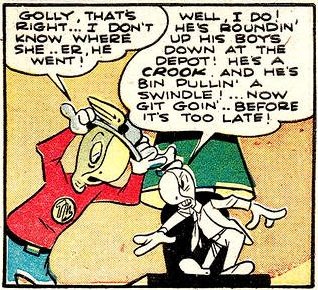
The Terrific Whatzit is a fictional superhero turtle appearing in American comic books published by DC Comics. DC's first talking animal superhero, the Terrific Whatzit first appeared in Funny Stuff #1 and was created by Martin Naydel.
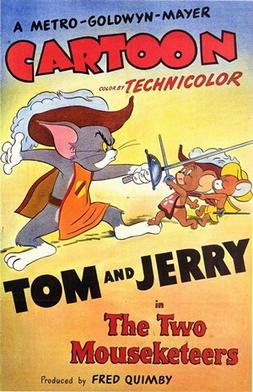
The Two Mouseketeers is a 1952 American one-reel animated cartoon and is the 65th Tom and Jerry short, produced in Technicolor and released to theatres on March 15, 1952 by Metro-Goldwyn-Mayer. It was produced by Fred Quimby and directed by William Hanna and Joseph Barbera. The short is a spoof of Alexandre Dumas' 1844 novel The Three Musketeers and its film adaptations, featuring the mice Jerry and his best friend, Nibbles as the "Mouseketeers" trying to raid the French king's banquet table, which is protected by Tom as a guard. Three years after the cartoon's release, the term "Mousketeer" was also used to refer to the child cast members of the television show, The Mickey Mouse Club.
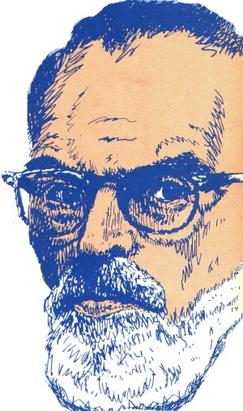
Sheldon Mayer was an American comics artist, writer, and editor. One of the earliest employees of Major Malcolm Wheeler-Nicholson's National Allied Publications, Mayer produced almost all of his comics work for the company that would become known as DC Comics.

Genius Jones is a comic book character from the Golden Age of Comic Books who first appeared in the DC Comics published, Adventure Comics #77. He was created by Alfred Bester and Stan Kaye.

Scott Joseph Shaw, often spelled Scott Shaw! and Scott Shaw? in Rick and Steve, is an American cartoonist, animator, and historian of comics. Among Shaw's comic-book work is Hanna-Barbera's The Flintstones, Captain Carrot and His Amazing Zoo Crew, and Simpsons Comics. He was also the first artist for Archie Comics' Sonic the Hedgehog comic book series.
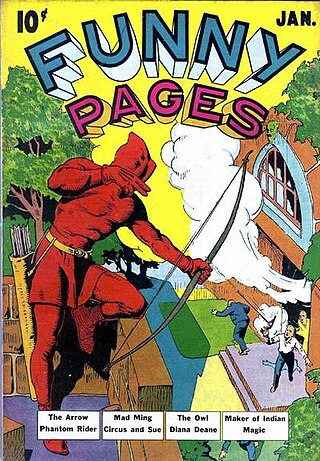
The Arrow is a fictional superhero created during the Golden Age of Comic Books. He was the first superhero published by Centaur Publications.

Wildfire is a fictional superhero in the DC Comics universe. One of the first female superheroes, she was originally published by Quality Comics during what comics historians and fans called the Golden Age of comic books. With her luxurious mane of red hair and revealing costume, she has been called "the sexiest super-hero of 1941".
The Fantom of the Fair is one of the earliest published Golden Age superheroes. He debuted in Centaur Publications' Amazing Mystery Funnies vol. 2, #7, the overall 11th issue of that title. He premiered, according to cover dates, the same month as DC Comics' Sandman, Fox Publications' The Flame, and Centaur's Masked Marvel. He was created by Paul Gustavson, who had previously created the Arrow for Centaur.
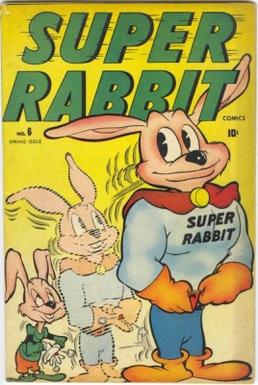
Super Rabbit is a fictional, talking animal superhero in comic books published by Timely Comics, a predecessor of Marvel Comics, during the 1930s and 1940s period fans and historians call the Golden Age of comic books. Created by cartoonist Ernie Hart, he first appeared in Comedy Comics #14.
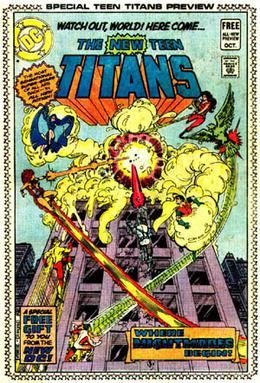
DC Comics insert previews were 16-page comic book stories inserted into issues of existing DC Comics series to promote new series usually debuting the next month. Running from 1980 to 1985, they consisted of a front cover, 14 pages of story, and a back cover that depicted the cover of the actual first issue. The addition of the insert did not entail an increase in the price of the comic book, and the cover copy called the insert "a special free 16-page comic!"

Blue Beetle is a long running comic book series that was first published by Fox Feature Syndicate before being a Charlton Comics title and currently a DC Comics title. The series starred certain characters with the same name.